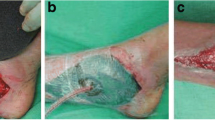Abstract
To evaluate resource utilization and direct economic costs of care for patients treated with negative pressure wound therapy (NPWT) in comparison with standard moist wound therapy (MWT) for preparation of diabetic foot TMA wounds for skin grafting. We retrospectively analyzed 56 patients who underwent transmetatarsal amputation (TMA) for infected diabetic foot from January 2014 to April 2015 at Jain Institute of Vascular sciences (JIVAS), Bangalore. Twenty-eight patients received negative pressure wound therapy (NPWT) (VAC® KCI, TX, USA) dressing while 28 received standard MWT daily. Resource utilization, revascularization procedures, number of secondary procedures (debridement), and total cost for wound bed preparation were calculated in both groups. There was no significant difference in both groups regarding age, gender, comorbidities, and number of revascularization procedures. All patients were having ankle brachial index (ABI) more than 0.8 or ankle pressures more than 80 mmHg before enrolling to study group. MWT group required more debridement (15 vs. 2; P = 0.0001). Average number of dressing changes performed per patients were 25 (range 20–32) for MWT versus 3 (range 2–5) in NPWT group. MWT group had more OPD visits compare to NPWT (14 vs. 2; P value =0.0001). Mean duration for wound bed preparation was 24.61 ± 3.20 days (range 20–32 days) in MWT group and significantly higher than NPWT group 9.11 ± 2.38 days (range 6–15 days) (P = 0.0001; 95% CI difference 13.99 to 17.01). The average total cost for wound bed preparation of TMA wound was Rs 26,875 ± 6810.5 in MWT group and was significantly higher than compared to Rs 23,089.29 ± 6637.5 in NPWT group (P = 0.03; 95% CI difference 182.54 to 7388.89). NPWT resulted in lower resource utilization, reduced costs, and acceleration of wound bed preparation for diabetic foot TMA wound in comparison to standard MWT.
Similar content being viewed by others
References
King H, Aubert RE, Herman WH (1998) Global burden of diabetes, 1995–2025: prevalence, numerical estimates, and projections. Diabetes Care 21:1414–1431
McCallon SK, Knight CA, Valiulus JP, Cunningham MW, McCulloch JM, Farinas LP (2000) Vacuum-assisted closure versus saline-moistened gauze in the healing of postoperative diabetic foot wounds. Ostomy Wound Manage 46(8):28–32 34
Nalini S, David G, Armstrong DG, Lipsky BA (2005) Preventing foot ulcers in patients with diabetes. JAMA 293:217–228
Reiber GE, Vileikyte L, Boyko EJ, del Aguila M, Smith DG, Lavery LA et al (1999) Causal pathways for incident lower extremity ulcers in patients with diabetes from two settings. Diabetes Care 22:157–162
Frykberg RG (1991) Diabetic foot ulcerations. In: Frykberg RG (ed) The high risk foot in diabetes mellitus. Churchill Livingstone, New York, pp 151–195
Frykberg RG (1998) Diabetic foot ulcers: current concepts. J Foot Ankle Surg 37:440–446
Frykberg RG, Armstrong DG, Giurini J, Edwards A, Kravette M, Kravitz S et al (2000) Diabetic foot disorders: a clinical practice guideline. American College of Foot and Ankle Surgeons. J Foot Ankle Surg 39(5 Suppl):S1–60
Winter GD (1962) Formation of the scab and the rate of epithelization of superficial wounds in the skin of the young domestic pig. Nature 193:293–294
Orgill DP, Bayer LR (2013) Negative pressure wound therapy: past, present and future. Int Wound J 10(Suppl 1):15–19
White R, McIntosh C (2008) Topical therapies for diabetic foot ulcers: standard treatments. J Wound Care 17:426–432
2011 Wound Care Product Manufacturing in the US: Market Research Report. 2011 URL http://www.ibisworld.com/industry/ wound-care-product-manufacturing.html [accessed on 1 Mar 2013]
2012 Wound Care Product Manufacturing in the US: Market Research Report. 2012. URL http://www.ibisworld.com/industry/ wound-care-product-manufacturing.html [accessed on 1 Mar 201
Kruse I, Edelman S (2006) Evaluation and treatment of diabetic foot ulcers. Clin Diabetes 24:91–93
Argenta LC, Morykwas MJ (1997) Vacuum-assisted closure: a new method for wound control and treatment: clinical experience. Ann Plast Surg 38:563–576
Morykwas MJ, Argenta LC, Shelton-Brown EI, McGuirt W (1997) Vacuum-assisted closure: a new method for wound control and treatment: animal studies and basic foundation. Ann Plast Surg 38:553–562
Akhlak Hussain, Kuldip Singh, and Mohinder Singh Cost effectiveness of vacuum-assisted closure and its modifications: a review. ISRN Plastic Surgery, vol. 2013, Article ID 595789, 5 pages, 2013
Banwell PE, Teotl L (2003) Topical negative pressure (TNP): the evolution of a novel wound therapy. J Wound Care 12(1):28–30
Thomas S (2001) An introduction to the use of vacuum assisted closure. World Wide Wounds:1–12
Armstrong DG, Lavery LA, Diabetic Foot Study Consortium (2005) Negative pressure wound therapy after partial diabetic foot amputation: a multicenter randomized controlled trial. Lancet 366:1704–1710
Fleischmann W, Lang E, Russ M (1997) Treatment of infection by vacuum sealing. Unfallchirurg 100(4):301–304
Amit kumar C Jain, Ajit kumar Varma, Mangalandan, Arun Bal, Harish Kumar (2011) Negative pressure wound therapy in salvaging the diabetic foot—an A.I.M.S experience. The Journal of Diabetic Foot Complications 3(1):13–16
Apelqvist J, Armstrong DG, Lavery LA, Boulton AJ (2008) Resource utilization and economic costs of care based on a randomized trial of vacuum-assisted closure therapy in the treatment of diabetic foot wounds. Am J Surg 195:782–788
Author information
Authors and Affiliations
Corresponding author
Rights and permissions
About this article
Cite this article
Narkhede, P.S., Vivekanand, Vishnu, M. et al. Resource Utilization and Cost Effectiveness of Negative Pressure Wound Therapy (NPWT) Versus Moist Wound Therapy (MWT) in Management of Diabetic Foot Transmetatarsal Amputation (TMA). Indian J Surg 80, 457–460 (2018). https://doi.org/10.1007/s12262-017-1630-2
Received:
Accepted:
Published:
Issue Date:
DOI: https://doi.org/10.1007/s12262-017-1630-2




